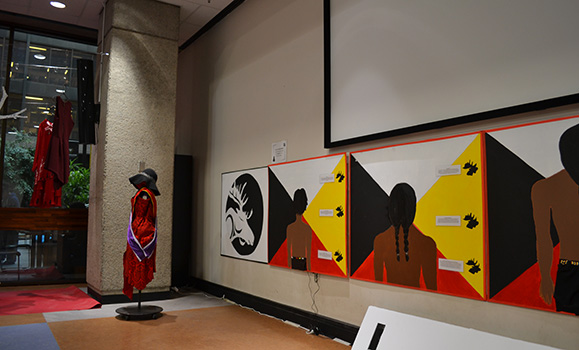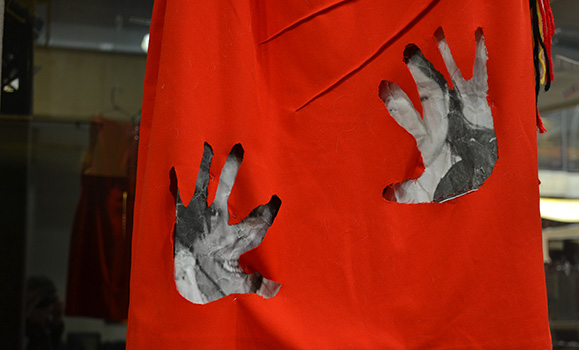An art collection created by students at a Halifax high school to honour missing and murdered Indigenous women, girls and 2SLGBTQQIA+ people has found a temporary new home at Dalhousie thanks to a unique community partnership.
The works, on display now in Ko’jua Okuom on the first floor of the Killam Library, were created by students from Halifax West High School under the direction of school leaders to help raise awareness about an issue that continues to impact Indigenous communities today.
The installation centres around a vivid display of red dresses — a symbol of the missing and murdered across Canada — and includes other impactful elements such as a tree hung with metallic leaves engraved with the names, ages and other details of missing individuals as well as interactive paintings and portraits that play audio stories when touched.
"We’ve put a lot of effort into building and making these displays, and from this experience we’ve learned of the enormous capacity that’s in schools to tackle difficult topics in a beautiful and engaging way," says Robin Jensen, the visual arts specialist at Halifax West who helped bring the project to life.
Wendy Lawrence, the Mi'kmaq Indigenous Support staff person at the school, first conceived of the project years ago following the release of the 2019 report from the National Inquiry into Murdered and Missing Indigenous Women and Girls. That report found that Indigenous women and girls are 12 times more likely to be murdered or to go missing than members of any other demographic group in Canada. Thousands of Indigenous women, girls and two-spirited people are believed to have been murdered or gone missing in Canada over the past three decades.
Lawrence was the driving force behind the project, recruiting Jensen and students to come together to help shine a light on the violence.

Names of missing and murdered women and girls are engraved on metallic leaves as part of one display.
Finding a broader audience
The pieces in the Halifax West collection ended up at Dal somewhat by chance after Leslie Phillmore, the university’s assistant vice-president, academic, parent of two former Halifax West students and member of the school's advisory council, saw them on display in the hallways.
Floored by the power of the students' work, she felt compelled to find a way to bring the collection to Dal in hopes it would spur the same sorts of conversations that it did at Halifax West.
"It’s not just reactive and highlighting the ongoing tragedy. It's got the balance of students doing something about it and learning from it,” says Phillmore. “Bringing this artwork here forged a positive connection between Dal and Halifax West on a very difficult and emotional topic and meant the impactful work these high school students had done with their teachers was able to be seen and experienced by a larger community."
Halifax West, which has agreed to loan the collection to Dal until next spring, collaborated with Dal Libraries to get the work installed this past summer ahead of the North American Indigenous Games.
Bug White, a first-year Dal computer science student who worked on the project while at Halifax West, says they appreciate the work finding a broader audience here at Dal.
“I feel like it is having a much bigger impact here as it’s a massive school compared to our high school,” says Bug, who moved to Halifax in 2015 from B.C. and whose family has roots in Manitoba’s Dene community.
“It was nice to get an opportunity to work on something that’s meant to be seen by a larger audience and to have such a big impact in regard to the subject matter,” they added.

Conductive paint used in another project prompts audio to play when a hand hovers over the moose heads.
Building deeper relationships
One remaining segment of the project — a series of circular wooden panels featuring student interpretations of the “Seven Sacred Teachings” — will be installed separately this fall in the Wallace McCain Learning Commons with assistance from the Dalhousie Art Gallery.
The art project suffered some delays due to the pandemic, but Jensen says rather than having a negative impact, it had the effect of deepening relationships and creating a more powerful sense of community among those involved.
“In many ways, for me this was a piece of reconcilaction in the sense that while we did produce something to look at and learn from, it had the greater impact of building relationships that have been really long lasting and meaningful.”
Members of the Dalhousie and Halifax community are encouraged to come by the Ko’jua Okuom to see the display when the room is open and not in use for scheduled events.

The red dress is a symbol of missing and murdered Indigenous women and girls in Canada.

